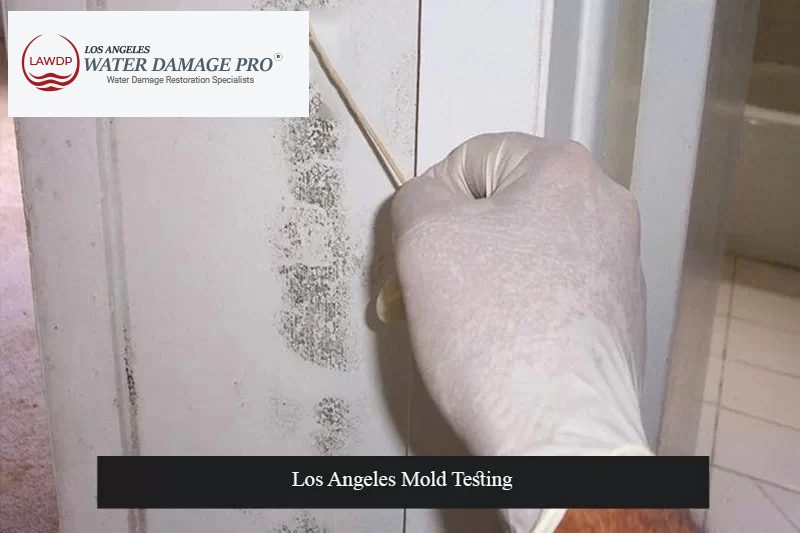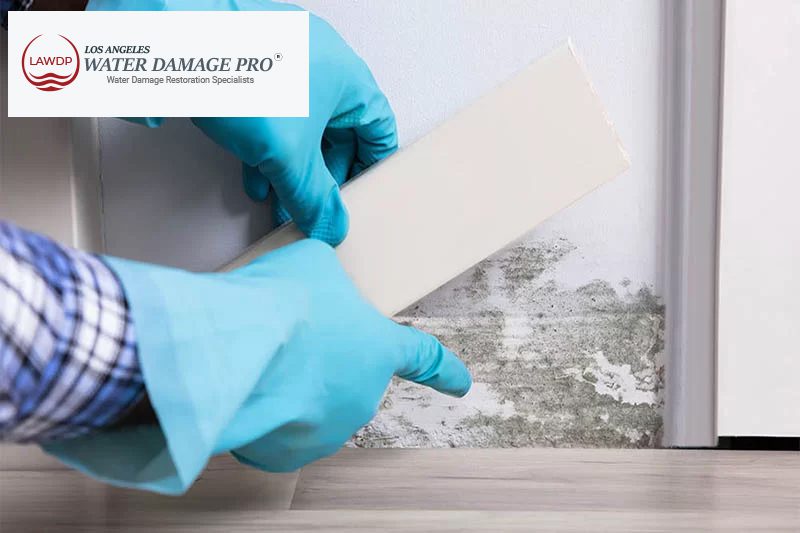Mold Testing in Los Angeles
Los Angeles mold testing is the best way to identify and remedy mold issues in your home or building. Mold is a common problem in many homes and buildings and can have serious health consequences if not appropriately addressed.

Mold testing is collecting and analyzing air and surface samples to identify the type and amount of mold growth in a given area. A professional mold inspector will take samples from the air, walls, and other surfaces in a home or business to determine the type and amount of mold present. The inspector can then recommend steps to reduce the amount of mold and prevent it from spreading and causing health problems. In this post, we’ll discuss different aspects of mold testing.
Why Should You Have Mold Testing Done?
- To identify the source of mold and take steps to prevent it from spreading.
- To ensure that the air quality in your home or business is safe.
- To protect the health of those living or working in the building.
- To save money in the long run by preventing costly mold damage and removal.
Signs You May Need Los Angeles Mold Testing
- Musty odors
- Visible mold growth
- Water damage
- Leaks or water stains
- Humidity levels above 50%
- Health issues such as allergies, asthma, and respiratory problems
What Does The Testing Entail?
- Visual Inspection: A certified mold inspector will visually inspect the property and identify any visible signs of mold growth, such as discolored walls and ceilings, musty odors, and dampness.
- Air Sampling: Air samples are taken from the property and analyzed in a lab to detect the presence of airborne mold spores.
- Surface Sampling: Surface samples are taken from suspected mold growth and analyzed in a lab to determine the type of mold present.
- Infrared Imaging: Infrared imaging can detect areas of moisture, indicating a potential mold growth problem.

Benefits of Professional Los Angeles Mold Testing
- An experienced, certified inspector will be able to identify potential sources of mold and take steps to prevent it from spreading. A professional mold inspector has the experience and equipment to thoroughly inspect your home or building and detect any mold issues.
- The inspector will use specialized equipment to collect and analyze samples to provide a comprehensive report on the type and amount of mold present.
- The report will provide detailed information on how to reduce mold levels and protect the health of those living or working in the building.
- It can also save money by preventing costly mold damage and removal.
- How to Test for Mold
- Visually inspect your home or building. Look for signs of mold, such as discoloration on walls or a musty smell. Pay special attention to areas prone to moisture, such as the bathroom or basement.
- Use a mold test kit. Several mold test kits, such as air or surface test kits, are available. These kits are easy to use and can give you an idea of the types and levels of mold present in your home or building.
What To Do If Mold Is Found
- Address the source of the moisture. The first step in remedying a mold problem is to address the moisture source causing the mold to grow. This could include fixing leaks, improving ventilation, or addressing condensation problems.
- Clean and remove the mold. Depending on the severity of the mold problem, it may be necessary to clean and remove the mold. This should be done by a professional with experience in mold remediation.
- Monitor the area. After the mold has been removed, it’s crucial to monitor the area to ensure it doesn’t return. This may involve periodically testing for mold and addressing any issues that arise.
When Should You Get Mold Testing in Los Angeles?
- After Water Damage: If your property has been affected by water damage, it must be tested for mold.
- Before Moving in: If you’re moving into a new home or apartment, it’s always a good idea to get it tested for mold, especially if you have allergies or asthma.
- After Remodeling: If you’ve recently completed a remodeling project, you should get your property tested for mold to ensure that the work didn’t cause a problem.
The Different Types of Mold Testing Techniques
Here are some of the different mold testing techniques that are often used across Los Angeles
| Test | Steps | Time Taken |
| Air Testing | Collect air samples using a specialized pump and cassette or agar plate. Send samples to a lab for analysis. | 1-2 days for sample collection. 1-5 days for lab analysis. |
| Surface Testing | Collect surface samples using a swab or tape lift. Send samples to a lab for analysis. | 1-2 days for sample collection. 1-5 days for lab analysis. |
| ERMI Testing | Collect dust samples from the home and send to a lab for analysis using the Environmental Relative Moldiness Index (ERMI). | 1-2 days for sample collection. 1-5 days for lab analysis. |
| PCR Testing | Collect samples using a swab or tape lift and use polymerase chain reaction (PCR) technology to detect mold DNA. | 1-2 days for sample collection. 1-5 days for lab analysis. |
| Culture Testing | Collect samples using a swab or agar plate and grow mold cultures in a lab to identify the type of mold present. | 1-2 days for sample collection. 5-14 days for lab analysis. |
Note that the timeframe for mold testing can vary depending on the number of samples collected, the type of analysis required, and other factors.
Tips for Preventing Mold
- Repair any leaks or water damage as soon as possible.
- Keep your home or business well-ventilated.
- Use a dehumidifier to reduce humidity levels.
- Clean and vacuum regularly to remove any mold spores.
- Monitor areas prone to mold growth, such as bathrooms and basements.
Los Angeles mold testing protects your home or business from mold growth. A qualified professional can help you determine the type and amount of mold present and take steps to prevent and remediate it. As a result, you can help keep your property safe and healthy with the proper precautions and regular maintenance.
FAQ
In general, mold testing is not typically covered by insurance unless it is specifically included as a provision in the policy.
However, some insurance policies may cover mold testing if it is necessary to investigate and document the cause and extent of damage caused by covered perils such as water damage, fire damage, or other types of covered damage.
In addition, if mold is found and it is determined that the mold is the result of a covered peril, such as water damage from a burst pipe, then the cost of mold remediation may be covered by insurance.
Testing for mold yourself can be risky and may produce inaccurate results. Here are some of the potential risks of testing for mold yourself:
Exposure to mold: If you are not trained in proper mold testing procedures, you may accidentally disturb mold spores and release them into the air. This can increase your exposure to mold and potentially cause health problems.
Inaccurate results: Without proper training and equipment, it’s easy to make mistakes when collecting samples or interpreting test results. This can lead to inaccurate results and an incomplete understanding of the extent and type of mold present.
False sense of security: If you conduct a test that does not detect mold, you may assume that your home is free of mold. However, it’s possible that the test was not conducted properly or that mold is present in areas that were not tested.
Wasted time and money: DIY mold testing kits can be expensive, and if you do not conduct the test correctly, you may need to hire a professional to conduct the test again, leading to wasted time and money.
If you detect mold in your home, it’s important to take action to address the problem and prevent it from spreading further. Here are some steps to follow when you detect mold at home:
Identify the source of moisture: Mold requires moisture to grow, so it’s important to identify the source of the moisture and address it. Common sources of moisture include leaks, condensation, and high humidity.
Wear protective gear: When cleaning up mold, it’s important to protect yourself from exposure to mold spores. Wear gloves, goggles, and a mask to protect your skin, eyes, and respiratory system.
Clean and disinfect affected areas: Use a mixture of water and detergent to clean the affected area, and then apply a disinfectant to kill any remaining mold spores. Follow the manufacturer’s instructions for the disinfectant and ensure proper ventilation during the cleaning process.
Dry the affected area: After cleaning and disinfecting the affected area, use a fan or dehumidifier to dry the area completely. This will help prevent the mold from re-growing.
Dispose of contaminated materials: If any materials are contaminated with mold and cannot be cleaned or salvaged, dispose of them properly. Double-bag the materials in plastic bags and dispose of them according to local regulations.
Consider professional help: If the mold covers a large area or if you are unable to remove the mold yourself, consider hiring a professional mold remediation company to remove the mold and prevent it from spreading further.


